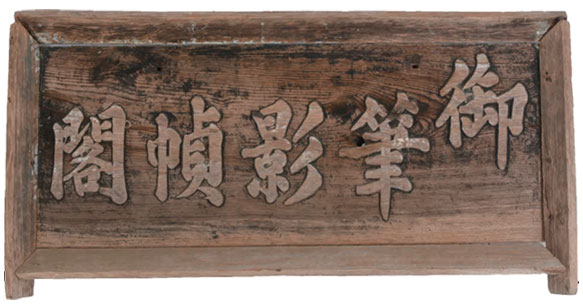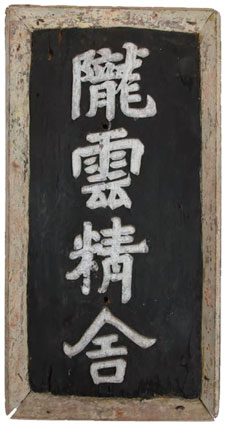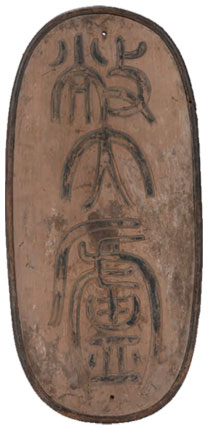- About Pyeon-Aek
- Summary of the Hanging Wooden Plaque
- Summary of the Hanging Wooden Plaque
- The Usage of the Hanging Wooden Plaque
The Materials and Shape of the Hanging Wooden Plaque
- [The hanging wooden plaque in Korea] Interpretation
The letter Pyeon in Chinese characters of Pyeon-aek (the hanging wooden plaque) means “ giving a title to the door”
The letter Pyeon in Chinese characters of Pyeon-aek (the hanging wooden plaque) means “ giving a title to the door” and in the shape, it was a wooden block on which the letters are written in widthways. In comparison, the letter Aek is a wooden block on which letters are written in lengthways in shape with the meaning “a flat wooden block hung over the wall or the plank”. Combining the two is called Pyeon-aek (the hanging wooden plaque).
The hanging wooden plaque are mainly made of wood. In China, it has a record that there were the hanging wooden plaque made of gold and silver etc. but the originals don’t remain. Some hanging wooden plaque made of copper, of iron and of stone etc. remained but most of them were made of wood, which is the same in Korea.
The wood used to make the hanging wooden plaque comes from juniper trees, ginkgo trees, pear trees and zelkova trees among others. The most commonly used trees are from pine trees for which Hwangjangmok (high quality pine tree) is used, for it can give delicate beauty, the color of pale yellow oozing out from the wood as times go on, so it was a favorite material.
The structures of the hanging wooden plaque are divided into three parts. First, a bottom plank, second is brim plank, the third is corner plank.
The hanging wooden plaque are mainly made of wood. In China, it has a record that there were the hanging wooden plaque made of gold and silver etc. but the originals don’t remain. Some hanging wooden plaque made of copper, of iron and of stone etc. remained but most of them were made of wood, which is the same in Korea.
The wood used to make the hanging wooden plaque comes from juniper trees, ginkgo trees, pear trees and zelkova trees among others. The most commonly used trees are from pine trees for which Hwangjangmok (high quality pine tree) is used, for it can give delicate beauty, the color of pale yellow oozing out from the wood as times go on, so it was a favorite material.
The structures of the hanging wooden plaque are divided into three parts. First, a bottom plank, second is brim plank, the third is corner plank.

(The structure of the hanging wooden plaque)
There are a lot of the hanging wooden plaque comprised of all three component parts and many which have only brim plank or bottom plank without brim plank and corner plank.
In the case of the brim plank, which completes a framing of the bottom plank with patterns painted on it, aims to pursue an aesthetic effect by painting patterns with the practical purpose of inhibiting the twist of the bottom plank of the hanging wooden plaque. The patterns of the brim plank arrange lotus design, arabesque design, fret design, and bat pattern and more in a row or they are used continuously and repeatedly.
The corner plank plays a role of maximizing the effects of decoration and giving a grand feeling. They are engraved in a shape of verse and sacred beasts and more then painted with showy coloring which doubles the beauty.
The bottom plank is made of processing trees and in case of big size one, two or three pieces of plank are joined. As it is produced with many pieces, some space between planks is left to allow for the expansion and contraction of the wood caused by temperature and humidity.
On the bottom plank, the letters on the hanging wooden plaque are engraved. The three techniques of intaglio, relief, and intaglio and relief are most commonly used. In the case of the calligraphic letters on the hanging wooden plaque produced in the Joseon Dynasty, the letters of famous calligraphers in China, Gu Yang-sun, So Sik, and Mi Bulet al. were collected and used. Also, frequently, famous scholars themselves engraved the letters. The most commonly used handwriting was the Seolam style, which originated from the Yuan Dynasty.
The number of letters is usually two to four letters and visual stability is incorporated in deciding the size of letters to the size of plank. If only the titles of the king or the name given in honor of the deceased king appear, the letters are used raising one letter above more than other letters. In this situation, it is produced taking priority over the political position rather than visual beauty.
In the case of the brim plank, which completes a framing of the bottom plank with patterns painted on it, aims to pursue an aesthetic effect by painting patterns with the practical purpose of inhibiting the twist of the bottom plank of the hanging wooden plaque. The patterns of the brim plank arrange lotus design, arabesque design, fret design, and bat pattern and more in a row or they are used continuously and repeatedly.
The corner plank plays a role of maximizing the effects of decoration and giving a grand feeling. They are engraved in a shape of verse and sacred beasts and more then painted with showy coloring which doubles the beauty.
The bottom plank is made of processing trees and in case of big size one, two or three pieces of plank are joined. As it is produced with many pieces, some space between planks is left to allow for the expansion and contraction of the wood caused by temperature and humidity.
On the bottom plank, the letters on the hanging wooden plaque are engraved. The three techniques of intaglio, relief, and intaglio and relief are most commonly used. In the case of the calligraphic letters on the hanging wooden plaque produced in the Joseon Dynasty, the letters of famous calligraphers in China, Gu Yang-sun, So Sik, and Mi Bulet al. were collected and used. Also, frequently, famous scholars themselves engraved the letters. The most commonly used handwriting was the Seolam style, which originated from the Yuan Dynasty.
The number of letters is usually two to four letters and visual stability is incorporated in deciding the size of letters to the size of plank. If only the titles of the king or the name given in honor of the deceased king appear, the letters are used raising one letter above more than other letters. In this situation, it is produced taking priority over the political position rather than visual beauty.

(A hanging wooden plaque which has raised letters)
The most common shape of the hanging wooden plaque is rectangular, of which the width is relatively wide, and also, the hanging wooden plaque in the shape of rectangular, of which the length is long are produced.

(A vertical hanging wooden plaque)
Furthermore, there are hanging wooden plaque in the shape of Choyeopaek (a shape of leaf) or oval, which is not common.


(The hanging wooden plaque in the shape of Choyeopaek and oval)
The bottom plank is colored almost always with white or black. When the bottom is white, the letters are painted black in contrast with it. When letters are black, the plank is colored white, so the letters, in contrast, look distinct, giving a clear feeling. At present, among the hanging wooden plaque used by common people, there are few. However, among the hanging wooden plaque used at temples or palaces, there are many plaque produced with a showy feature gilding.








